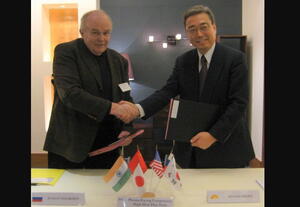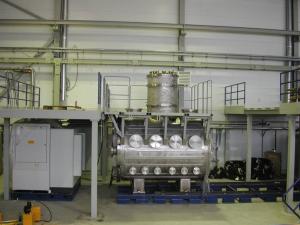One more down
On Tuesday, 23 February, Procurement Arrangement number 32 for the high heat flux testing of ITER's plasma-facing components was signed in Paris between the ITER Organization and the Domestic Agency of the Russian Federation. This is the third Procurement Arrangement which has been signed in the divertor area. The other two were signed last June for the procurement of the outer target and the dome with Japan and Russia, respectively.
The testing of the plasma-facing components will be performed at a new facility under construction at the Efremov Institute in St. Petersburg by means of a powerful 800,000 watt electron-beam-gun. Electrons will be accelerated through an applied voltage of 60 kV. The energy that is released when they strike the targets simulates the heat delivered by the plasma to the surfaces of the components. ITER's plasma-facing components are designed to cope with heat loads of up to 20 megawatts per square metre. "From an engineering point of view that might sound painful," says Mario Merola, ITER's Internal Components Division head. "On the other hand, heat from the plasma is exactly what we want."
To withstand the extreme thermal loads is not the only challenge for the plasma-facing components. Thermal fatigue due to the high number of operating cycles (several thousands) is another. The heat flux tests will thus be performed in so called on/off cycles in order to assess the thermal fatigue of the components. The assessment of the behaviour of plasma-facing components under cycling heat loads is essential to demonstrating their fitness for the purpose of the ITER machine.
The value of this Procurement Arrangement is EUR 12.38 million.



